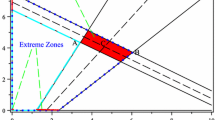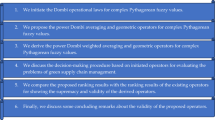Abstract
This study develops a dual inexact fuzzy chance-constrained programming (DIFCCP) method for planning municipal solid waste (MSW) management systems. The concept of random boundary interval (RBI) is introduced to address the high uncertain parameters in the studied system. Fuzzy flexible programming and chance-constrained programming are also introduced to take into account the uncertainties of RBIs and various uncertainties in MSW management system. Compared with the existing methods, the developed method could deal with the uncertainty without simplification and thus is more robust. Moreover, the potential system-failure risks in MSW management system due to the existing uncertainties could be quantified by means of violation levels and satisfaction levels in DIFCCP. The developed method then is applied to a MSW management system. The obtained solutions could be used for generating efficient management schemes. The values of violation and satisfaction levels could help decision makers understand the tradeoffs between system cost and system-failure risk, and identify desired strategy according to the practical economic and environmental situation.





Similar content being viewed by others
References
Babaeyan-Koopaei K, Ervine DA, Pender G (2003) Field measurements and flow modeling of overbank flows in River Severn, UK. J Environ Info 1:28–36
Byun DW, Kim ST, Cheng FY, Kim SB, Cuclis A, Moon NK (2003) Information infrastructure for air quality modeling and analysis: application to the Houston–Galveston ozone non-attainment area. J Environ Info 2:38–57
Chanas S, Zielinski P (2000) On the equivalence of two optimization methods for fuzzy linear programming problems. Eur J Oper Res 21:56–63
Chang NB, Lu HY (1997) A new approach for long-term planning of solid waste management system using fuzzy global criterion. J Environ Sci Health (A) 2:1025–1047
Chang NB, Wang SF (1995) Solid waste management system analysis by multi-objective mixed integer programming model. J Environ Manag 48:17–43
Chang NB, Wang SF (1997) A fuzzy goal programming approach for the optimal planning of metropolitan solid waste management systems. Eur J Oper Res 99:303–321
Cheng GH, Huang GH, Li YP, Cao MF, Fan YR (2009) Planning of municipal solid waste management systems under dual uncertainties: a hybrid interval stochastic programming approach. Stoch Environ Res Risk Assess 23:707–720
Chi GF, Huang GH (1998) Long-term planning of integrated solid waste management system under uncertainty. University of Regina Report submitted to the City of Regina, Saskatchewan, Canada
Guo P, Huang GH (2009) Two-stage fuzzy chance-constrained programming: application to water resources management under dual uncertainties. Stoch Environ Res Risk Assess 23:349–359
Guo P, Huang GH, He L (2008) ISMISIP: an inexact stochastic mixed integer linear semi-infinite programming approach for solid waste management and planning under uncertainty. Stoch Environ Res Risk Assess 22:759–775
Huang GH (1998) A hybrid inexact-stochastic water management model. Eur J Oper Res 107:137–158
Huang GH, Baetz BW, Patry GG (1992) An interval linear programming approach for municipal solid waste management planning under uncertainty. Civ Eng Environ Syst 9:319–335
Huang GH, Baetz BW, Patry GG (1993) A grey fuzzy linear programming approach for municipal solid waste management planning under uncertainty. Civ Eng Environ Syst 10:123–146
Huang GH, Baetz BW, Patry GG (1994) Grey dynamic programming (GDP) for solid waste management planning under uncertainty. J Urban Plan Dev 120:132–156
Huang GH, Baetz BW, Patry GG (1995a) Grey integer programming: an application to waste management planning under uncertainty. Eur J Oper Res 83:594–620
Huang GH, Baetz BW, Patry GG (1995b) Grey fuzzy integer programming: an application to regional waste management planning under uncertainty. Socio-Econ Plan Sci 29:17–38
Huang GH, Sae-Lim N, Liu L, Chen Z (2001) An interval-parameter fuzzy-stochastic programming approach for municipal solid waste management and planning. Environ Model Assess 6:271–283
Huang YF, Baetz BW, Huang GH, Liu L (2002) Violation analysis for solid waste management systems: an interval fuzzy programming approach. J Environ Manag 65:431–446
Kirca J, Erkip N (1998) Selecting transfer station locations for large solid waste systems. Eur J Oper Res 38:339–349
Leimbach M (1996) Development of a fuzzy optimization model, supporting global warming decision-making. Environ Res Econ 7:163–192
Li YP, Huang GH, Chen X (2009) Multistage scenario-based interval-stochastic programming for planning water resources allocation. Stoch Environ Res Risk Assess 23:781–792
Liu ZF, Huang GH, Liao RF, He L (2009) DIPIP: Dual Interval Probabilistic Integer Programming for Solid Waste Management. J Environ Info 14(1):66–73
Lu HW, Huang GH, He L (2009) An inexact programming method for agricultural irrigation systems under parameter uncertainty. Stoch Environ Res Risk Assess 23:759–768
Maqsood I, Huang GH, Huang YF, Chen B (2005a) ITOM: an interval-parameter two-stage optimization model for stochastic planning of water resources systems. Stoch Environ Res Risk Assess 19:125–133
Maqsood I, Huang GH, Yeomans JS (2005b) An interval-parameter fuzzy two-stage stochastic program for water resources management under uncertainty. Eur J Oper Res 167:208–225
Nie XH, Huang GH, Li YP, Liu L (2007) IFRP: A hybrid interval-parameter fuzzy robust programming approach for waste management planning under uncertainty. J Environ Manag 84:1–11
Papoulis A, Unnikrishna Pillai S (2002) Probability random variables and stochastic processes. The McGraw-Hill Companies, Inc, New York
Qin XS, Huang GH, Zeng GM, Chakma A, Huang YF (2007) An interval-parameter fuzzy nonlinear optimization model for stream water quality management under uncertainty. Eur J Oper Res 180:1331–1357
Rose C, Smith MD (1996) The multivariate normal distribution. Mathematica J 6:32–37
Tan Q, Huang GH, Cai YP (2009) Identification of optimal plans for municipal solid waste management in an environment of fuzziness and two-layer randomness. Stoch Environ Res Risk Assess. doi:10.1007/s00477-009-0307-1
Tong L (1990) The multivariate normal distribution. Springer-Verlag, New York
Wilson DC (1985) Long term planning for solid waste planning. Waste Manag Res 3:203–216
Xu Y, Huang GH, Qin XS, Cao MF (2009) SRCCP: a stochastic robust chance-constrained programming model for municipal solid waste management under uncertainty. Resour Conserv Recy 53(6):352–363
Xu Y, Huang GH, Qin XS, Cao MF, Sun Y (2010) An interval-parameter robust optimization model for supporting municipal solid waste management under uncertainty. Waste Manag 30(2):316–327
Yeomans JS (2008) Applications of Simulation-Optimization Methods in Environmental Policy Planning under Uncertainty. J Environ Info 12(2):174–186
Yeomans JS, Huang GH (2003) An evolutionary grey, hop, skip, and jump approach: generating alternative policies for the expansion of waste management. J Environ Info 1:37–51
Yeomans JS, Huang GH, Yoogalingam R (2003) Combining simulation with evolutionary algorithms for optimal planning under uncertainty: an application to municipal solid waste management planning in the regional municipality of Hamilton-Wentworth. J Environ Info 2:11–30
Zeng Y, Trauth KM (2005) Internet-based fuzzy multicriteria decision support system for planning integrated solid waste management. J Environ Info 6:1–15
Zhu Z, Revelle C (1993) A cost allocation method for facilities sitting with fixed-charge cost functions. Civ Eng Environ Syst 7:29–35
Acknowledgements
This research was supported by the Major State Basic Research Development Program (2005CB724200). The authors are grateful to the editor and the reviewers for their insightful comments and suggestions in improving the quality of this paper.
Author information
Authors and Affiliations
Corresponding author
Appendix
Appendix
1.1 The process of acquiring an RBI
The process of acquiring an RBI is provided as follows. Firstly, samples of the possible intervals for RBI can be acquired:
where (u i , v i ) is the value of the ith sample. Secondly, calculate the mean vector and covariance matrix of the samples:
Thirdly, suppose that the inputs follow a distribution based on the mean vector and covariance matrix. A hypothesis testing can be undertaken. A joint distribution function can then be identified for (B − i , B + i ) [i.e. = f(s, t)]. Suppose [c, d] to be the range of B + i . Finally, the probability density function (PDF) of B − i can be generated:
Suppose [a, b] is the range of B − i . Similarly, we can get the PDF of B + i as follows:
Rights and permissions
About this article
Cite this article
Cao, M.F., Huang, G.H., Sun, Y. et al. Dual inexact fuzzy chance-constrained programming for planning waste management systems. Stoch Environ Res Risk Assess 24, 1163–1174 (2010). https://doi.org/10.1007/s00477-010-0390-3
Published:
Issue Date:
DOI: https://doi.org/10.1007/s00477-010-0390-3




